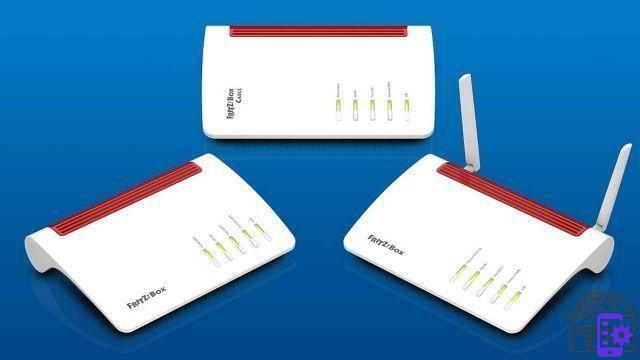
Many are already familiar with AVM; for those who have never heard of it, it is a German company that produces network equipment for medium-high range domestic use. AVM's routers, which are often called FritzBoxes or even just Fritzs, they are based on Linux, offer many interesting technical features and, above all, with an advantageous price / performance ratio. So let's go and see in this review the new flagship model from AVM: the Fritz! Box 7590 AX.
The review of Fritz! Box 7590 AX

It is always very difficult to review a device like the Fritz! Box 7590 AX, because it is proposed as the top of the range for a manufacturer who, indisputably, has excellent quality products. We are in a bit of the same situation as a supercar test-drive; sure it's beautiful, you can't say no. But exactly how much prettier is she than all the rest? To say this, in our opinion there are two aspects that need to be addressed. On the one hand, for those who are not yet AVM customers, what it gives us more than many other products for home use. On the other hand, for those who already know the company, what step forward has there been compared to the previous model.
The Fritz! Box software
All AVM routers are carried out in parallel from a software point of view. So the available features really depend only on the hardware of the purchased model. This, we must say, we appreciate a lot from the manufacturer. At the time of this writing, the most up-to-date version of Fritz! OS is 7.29. Note that the software name ends with OS, precisely because we should not speak of a firmware, as in many other cases, but of a real operating system Linux based.
Fritz! Box as a domestic product
All routers, some more or less, have two faces: the friendly one that pops up when you turn it on for the first time and with which, rightly so, they try to get us connected to the Internet as soon as possible and the other, the much more intimidating one we deal with at the moment we want customize their operation once we are up and running. The second obviously tends to be more complicated as the available features increase.
Installation
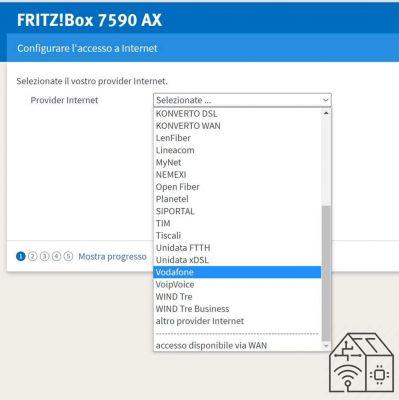
During the installation phase, Fritz! Box asks us the usual question about the interface language and then we move on to choose our Internet provider. And this, in our opinion, is already quite a departure from most of the competitors. Often the connection with the provider is either bound by the distributor (as in the case of equipment that comes to us from our ISP) or requires you to fill in a series of parameters which, for non-technical people, are rather hermetic. With Fritz! Box we find a ready-made list of providers to choose from (the major Italians are included) and we don't have to worry about anything.
The AVM product also allows you to do telephony and provides us with an integrated answering machine with the ability to record messages and easily block unwanted numbers (which should not be underestimated). Telephony can be both classic, and in this case we will connect the twisted pair to the router, both VoIP (Veye osee IP) by entering the data of our provider. Whatever the telephone service used, we will be able to use both the classic telephone, because the router can act as a DECT base for up to six cordless phones, both our mobile with a free AVM software.
Customization
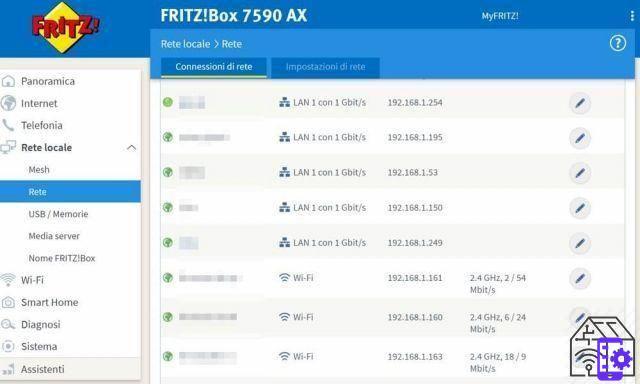
The configuration phase, after installing the router, is always a bit complex. This is because the options are many and often the interface language is very technical. Therefore, the products on the market either take the path of not letting us configure anything and manage everything themselves or they expose us very complex menus and we must take our responsibilities on the choices we make. AVM obviously takes the second route for its products. However, unlike other routers we have configured in the past, there is an effort to make the interface as accessible and informative as possible. The terms are never extremely technical and when they are they are accompanied by clear descriptions. Furthermore, in case of need, there is always a link just a click away at the top right that will send us to the right page of an online manual.
Fritz! Box at home, but also for the office and home working
If we are evaluating a product like Fritz! Box it is clear that we need something more customizable than average, even if we are not experts. This is because we can be fans but also out of necessity. For example, if we need to set up a small office or work from home, it may represent a cheaper solution than others but still capable of responding to our requests. Indeed, AVM devices provide a series of advanced features which aren't typically available on devices in that price range. Listing them all would be long and boring, but we would like to mention at least the ones that make this product interesting even for a small / medium office and for those who work at home.
A telephone switchboard
The answering machine, as already mentioned, is integrated and easy to use. In addition, you can manage calls, including forwarding, based on time and calling number. If we have more than one operator, then, it is possible to select the most convenient service based on the number called. Finally, a shared directory and internal calls are also managed. In short, perhaps it can be the replacement for a corporate PBX, but for a small office with 4/5 IP phones it is in our opinion a very valid solution.
Un server VPN
Very often it happens that we are traveling and want to access a device within our private network. For example, if we need to retrieve a document on the NAS, access our desktop PC or we want to check the status of the thermostat. One possible solution, which should be avoided at all, is to expose the device to the Internet. Breast, we can connect to our private network via a VPN (Virtual Private Nnetwork) managed by the Fritz! Box and operate as if we were physically in the office or at home. In fact, we can define local users and give each of them specific entry permits.
Control over network access and availability
Inside the router it is possible to associate a profile to each single device (obviously, several devices can refer to the same profile). For each profile it is possible to determine which Internet services it can access and in which time slots it has network availability. In the case of the web service it is also possible to define lists of allowed or forbidden sites to which to connect. Beyond parental control, in in an office it may be desirable to limit access to the external network to the strict minimum for all non-PC devices, such as sensors for home automation, a television, printers or even the NAS.
AVM's five-star service
To close this section we find it useful to also mention the added value given by the (free) registration of the router to the AVM site. This added value is not decisive for the domestic user but becomes useful in the workplace.
First of all, registering our router will give us the availability of an entry point on the myfritz.net domain. This means that there will be a virtual host of the xxxxxxxxxxxxxx.myfritz.net type that will always point to our device, even if the provider does not provide a fixed IP service. This way connecting via VPN will never be a problem. Obviously, if we do not expose services to the outside, the address cannot be used to fraudulently enter our home or office.
Once a week we will receive a summary email on the status of all our devices complete with software version, some usage statistics and reports of possible updates.
For the most important security updates, the router manages itself, but it does so by alerting us. In the sense that we will receive an informative email the day before indicating the update and restart schedule. The advantages for those who work from home, especially when available at night, are quite evident.
Technical characteristics of the new model
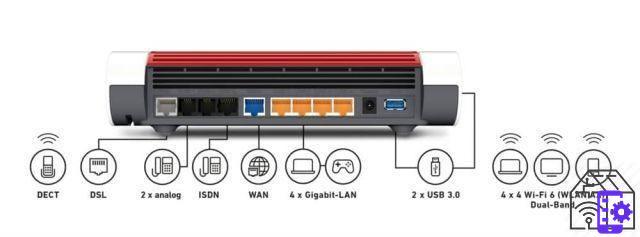
The Fritz! Box 7590 AX is, from an engineering point of view, certainly a great product. The technical characteristics are remarkable even if, on the hardware sector, quite in line with other high-end routers. In fact, we find the possibility to connect to ADSL lines up to 300 Mbps, 4 ports at 1 Gbps and a WAN port to connect it in cascade to an existing network or to the transceiver for the optical fiber. The real point of distinction of this model, however, is the introduction of the WiFi network according to the new 802.11ax standard (hence its name) marketed as WiFi (generation) 6.
For those considering an upgrade
For those who already own the old model of the 7590 and are considering an upgrade, there are some new features.
From the point of view of the network, the AX model supports ADSL2 + but is no longer compatible with ISDN. ISDN which, in our opinion too, however, it was time to leave us behind. Support is given for a key (not included) for 3G / UMTS / HSPA mobile network. On this point, we admit that we were a bit perplexed due to the fact that in Europe the 3G network is being phased out and there are huge investments in 5G. Therefore, we would have expected a more push in the 5G direction.
As for the physical part, the container is slightly larger than the previous model even if not by much (254x63x191 against 250x48x185). From an energy point of view, another little surprise, consumption passes from a range of 9-10W to 14-16W which, we agree, will not be heard either in the bill or on the meter, but we have found it to be in slight contrast with the green policies that have been talked about so much lately.
Plus, of course, there is WiFi 6, but this deserves a separate section.
WiFi 6, the big news
The sixth generation of WiFi networks adopts a transmission technique called MIMO (Mmultiple In/Mmultiple Out) which, simplifying to the extreme, makes use of several antennas to optimize the use of the transmission spectrum. This technique it allows to increase the transmission capacity and at the same time obtain better performances in crowded environments. Furthermore, thanks to the introduction of a methodology called TWT (Tmoney Wfake Time) it is possible to save power to mobile devices and thus improve the performance of their batteries.
This is all very interesting, but to be able to fully enjoy it, the devices that connect to the router must also be equipped with Wi-Fi 6. And this, today, is unfortunately the case for a minority of equipment on the market. So, if we're honest, it might be difficult to see immediate effects in the home. Nonetheless, it cannot be ruled out that a Wi-Fi 6 receiver may already bring benefits in the management of older generation devices today who use Wi-Fi 5. To do this, we took a 7590 AX and put it on the test bench to compare it to its little brother, the 7590.
Our "road test"
Our intention was to check if the new model can handle Wi-Fi interference better than the old one. For this type of test it makes little sense to measure a transfer to or from the Internet, because the bottleneck will inevitably be our provider. We then attached a hard drive directly to the router and used a PC with Wi-Fi 5 for download a very large file from your hard drive using a browser. That way, the only network to determine performance would be Wi-Fi. The hard disk, made a test, still had a transfer capacity equal to or greater than 1 gigabit per second; so he wouldn't be the one to limit performance.
After the first test, without disturbances, the performance observed on the PC can be seen in the image below.

The slight jaggedness depends on the timing of our system (which in the meantime also has to do something else, such as updating the video) and on the flow control of the TCP protocol, on which the browser rests for data transfer. For the more curious, the flow control in a protocol is used to use the right amount of bandwidth to equally divide a transmission channel with other services. This fundamental functionality, however, introduces a slight instability over time and does not allow us to use the whole channel to transmit data. In fact, in the graph we are around 350/400 megabits per second (the values shown are in megabytes).
Wi-Fi 5 and network traffic
We then moved on to the second phase. We added a second PC that, over 90 seconds of experiment, flooded the network with no-flow control (UDP) messages in the middle 30 seconds. That is, it produced packets that would consume all the bandwidth like a raging river. Downloading with our browser is obviously penalized by this as the flow control leaves room for the new data flow. However, the better the protection offered at the Wi-Fi level, the more stable the download remains.
With Fritz's old fetlock! Box 7590 (with Wi-Fi 5) we got this:

That is one download reduction to 5 megabits per second.
Be careful though. Let us remember that the conditions in which we have put ourselves are very extreme (the router is, so to speak, suffering a lot), so believe it or not, this is normal behavior.
Comparison with Wi-Fi 6
Doing the same experiment with the Fritz! Box 7590 AX, instead, we got this:

This image, we believe, speaks for itself.
Therefore, at the end of our experiment, we can support the hypothesis that, even if we don't use Wi-Fi 6 devices in our house, however, we may see a performance gain in case of heavy traffic by installing a router that makes use of the new technology. This improvement, of course, it depends on how the Wi-Fi 6 is designed but also on the way the router is built and how the operating system manages the antenna. We therefore ask you to take this experiment for what it is: a comparison between these two specific models and not a test of technology in the broader sense.
There's no rose without thorns
Of course, to say that the Fritz! Box 7590 AX is a perfect item would not be honest. We have found some flaws, in addition to the concerns we have already expressed. The things that didn't leave us excited though, they are not hardware related.
In general, AVM is a pure German company and this is sometimes also seen in the way they take care of certain aspects of their products. Regionalization in Italian, for example, we found it not very clear in some places and, actually, we would like to suggest to keep the interface in English to better contextualize some technical terms. The same kind of problem, a little stronger, comes up with the configuration of the VPN. In fact, in the case of Windows 10 (and fortunately only for that), as also indicated on the manufacturer's website, the configuration can only be done with software written in German.
The other thing that surprised us a bit was the fact that the router can function as a control unit for home automation, but only for devices produced by the same house and is not compatible with Alexa and Google Home.
These are two visible defects but they do not compromise the usability of the product. Also, not being tied to hardware, it cannot be ruled out that AVM will fix things in the near future.
The Fritz! Box 7590 AX review at a glance
AVM renews its top-of-the-range router by making us available a great device at an attractive price that finds application both at home and in small / medium offices. The main innovation consists in the introduction of Wi-FI 6 which, although it is not yet particularly widespread in devices, from our experiments it could still be an advantage, especially if you are planning a model upgrade.
It's hard not to recommend such a product, despite some problems related to the management of regionalization. It would be like saying that we don't like a racing car because of the floor mats.
Discount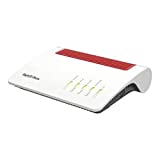 AVM FRITZ!Box 7590 AX Modem Router Wi-Fi 6 Dual Band 2.4GHZ...
AVM FRITZ!Box 7590 AX Modem Router Wi-Fi 6 Dual Band 2.4GHZ...
- Suitable for ADSL2 + and VDSL connections
- Speeds up to 300 Mbit / s thanks to VDSL Supervectoring 35b
- Safe use of the Internet thanks to the preset firewall




















![[Review] Samsung Powerbot VR7000: the robot vacuum cleaner from Star Wars](/images/posts/6bc44de38605b5c0fa12661febb1f8af-0.jpg)





